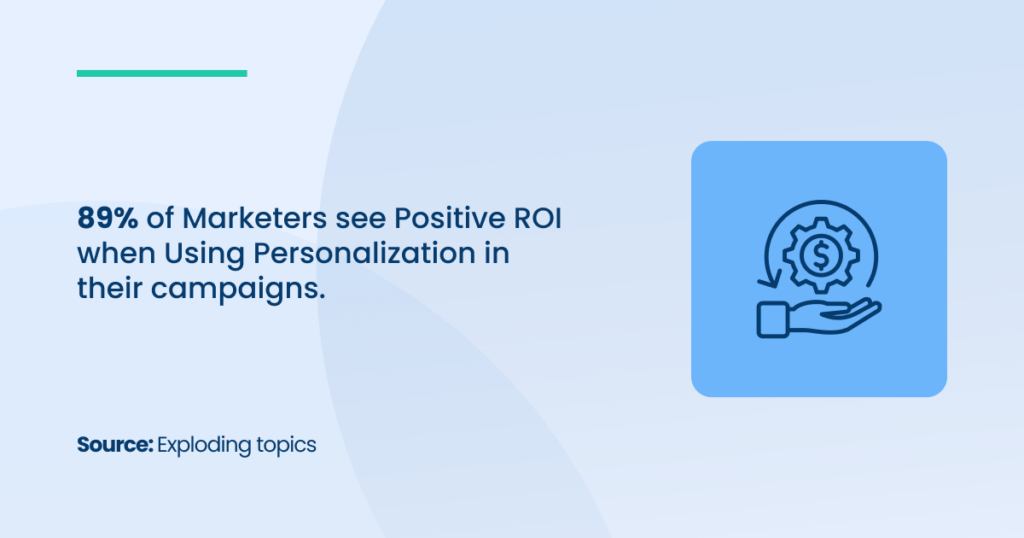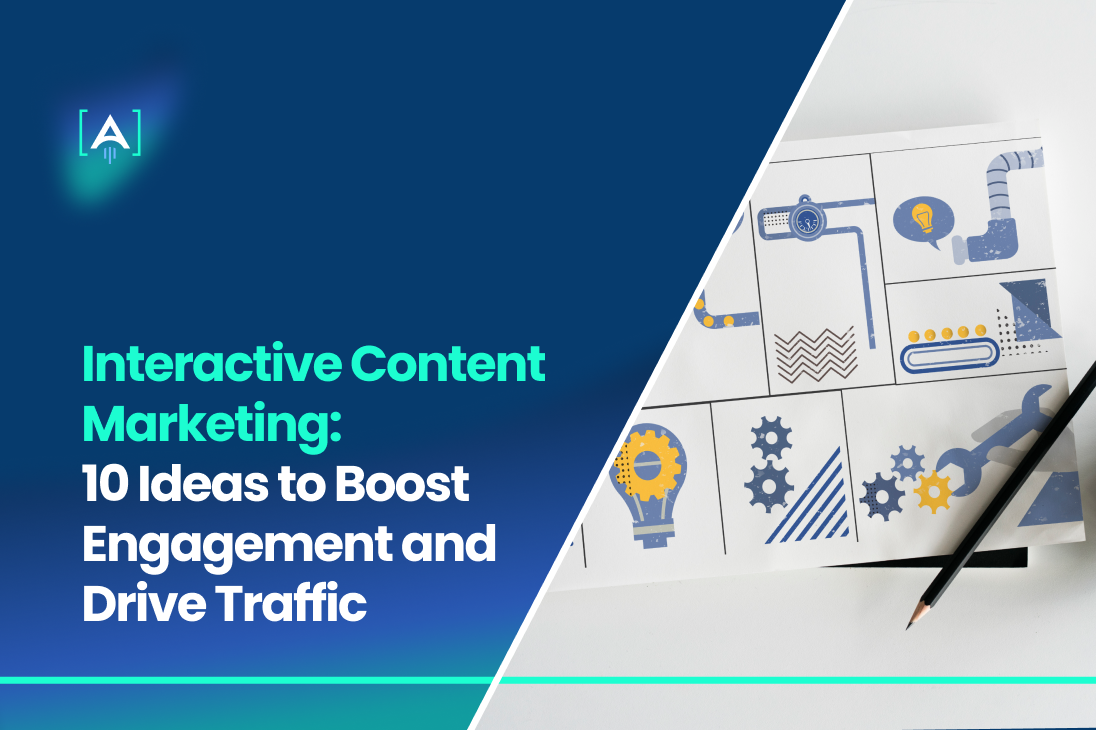Capturing and holding the attention of your audience is more challenging than ever.
Traditional content marketing strategies are no longer enough.
To stand out and drive engagement, you need to create interactive, engaging, and memorable content.
Content Marketing research highlights that it aims to educate consumers by providing valuable information. This will create brand loyalty, and purchases will be made in the future.
Moreover, over a third (36%) of businesses reported that 10% to 29% of their budget is given to content marketing.
This investment underscores the importance of collaborating with a Content Marketing Agency to maximize ROI and drive effective results.
The blog post will cover the importance of interactive content marketing and the essential 10 ideas to boost engagement.
Why Interactivity Matters in Today’s Digital Landscape
In the rapidly evolving world of digital marketing, interactive content marketing has become a game-changer for brands aiming to capture and retain the attention of their target audience.
The traditional static content is no longer sufficient in an era where consumers are inundated with information from multiple channels.
Interactivity is not just a buzzword; it’s a fundamental shift in how brands communicate and engage with their customers.

Interactive content marketing involves creating content that requires active participation from the user, transforming them from passive readers into engaged participants.
This approach leverages various interactive elements such as quizzes, polls, calculators, and videos to provide a more engaging experience.
For example, incorporating interactive social media posts on platforms like Instagram and Facebook can boost user engagement and foster a deeper connection with the audience.
1. Quizzes and Assessments
In interactive content marketing, quizzes, and assessments have emerged as powerful tools to captivate audiences and foster deeper engagement.
By creating interactive content that resonates on a personal level, brands can entertain and gather valuable insights into their audience’s preferences, behaviors, and needs.
Engaging Users with Personalized Quizzes
Personalized quizzes transform passive content consumption into an active experience. Users are no longer mere spectators; they become participants who engage directly with the content.
In 2023, a global survey unveiled that seven out of ten business leaders were ramping up their investments in personalization.

This interactivity is crucial in today’s digital age, where attention spans are short and the competition for user engagement is fierce. Quizzes offer a dynamic way to stand out, providing a personalized touch that can significantly enhance user experience.
Types of Quizzes
Quizzes come in various forms, each serving different purposes within a marketing strategy. The two most prevalent types are personality quizzes and knowledge tests.
Both types can be leveraged to achieve specific marketing goals, such as increasing engagement, generating leads, and gathering audience insights.
Integrating Quizzes into Your Marketing Strategy
To maximize the impact of quizzes in your marketing strategy, it’s essential to align them with your brand objectives and audience interests.
- Relevance: Ensure that the quiz topic is relevant to your brand and valuable to your audience. This relevance increases the likelihood of engagement and sharing.
- Interactivity: Incorporate interactive elements that enhance the user experience. This could include dynamic results pages, personalized recommendations, or gamified features.
- Promotion: Leverage social media platforms to promote your quizzes. Utilize paid advertising, influencer partnerships, and organic posts to reach a wider audience.
- Data Collection: Use quizzes as a tool for lead generation by integrating sign-up forms. Be transparent about how you will use the data and provide value in exchange.
- Content Integration: Combine quizzes with other forms of content, such as interactive infographics or interactive posts, to create a cohesive and engaging content ecosystem.
- Analysis and Optimization: Regularly analyze quiz performance and user responses to gain valuable insights. Use this data to refine your quizzes and overall content strategy.
2. Interactive Infographics
In the age of information overload, capturing the attention of consumers has become a significant challenge for marketers.
Source: Azarian Growth Agency
Interactive infographics have emerged as a powerful solution in interactive content marketing, enabling brands to present complex data in an incredibly engaging and visually appealing manner.
By combining compelling visuals with interactive elements, these infographics transform static information into dynamic experiences where users can actively participate, enhancing both understanding and retention.
Why Use Interactive Infographics
Simplifies Complex Data
One of the primary advantages of interactive infographics is their ability to simplify complex data. In industries like finance, healthcare, or technology, conveying intricate information can be daunting.
Interactive infographics break down this data into manageable pieces, using visuals and interactive elements to make it more digestible.
By leveraging online tools and platforms specialized in creating interactive visuals, marketers can transform dense reports into engaging content that resonates with their audience’s interests.
This approach aligns with effective content curation strategies, ensuring that only the most pertinent information is highlighted while unnecessary details are omitted.
Encourages User Interaction
Interactive infographics invite users to engage directly with the content, turning passive viewers into active participants.
Features like hover effects, clickable elements, and animations encourage users to explore the infographic in depth.
Source: Good Firms
For instance, a company might use an interactive infographic to demonstrate how their product works.
Users could click on different components to see detailed explanations or animations, providing a hands-on understanding of the product’s benefits.
This method is a prime example of branded content marketing, where the content itself serves as a subtle promotion of the brand’s offerings.
Content Repurposing and Gamification
Interactive infographics also offer opportunities for content repurposing. Brands can take existing static infographics or data-heavy reports and transform them into interactive experiences.
This not only breathes new life into existing content but also maximizes the return on investment for content creation.
Incorporating elements of content gamification can further enhance user engagement. By adding quizzes, challenges, or rewards within the infographic, brands can make the experience more entertaining and memorable.
Gamified content encourages users to delve deeper and can significantly boost interaction rates.
3. Polls and Surveys
Understanding your audience is paramount in crafting effective marketing strategies. Polls and surveys have become indispensable tools in interactive content marketing, offering a direct line to consumer opinions and preferences.
By encouraging users to actively participate, brands can gather valuable insights while simultaneously boosting engagement.
4. Calculators and Tools
In the dynamic world of interactive content marketing, calculators and tools have emerged as powerful assets for brands aiming to engage consumers meaningfully.
By offering practical interactive tools like ROI calculators and budget planners, companies can facilitate active engagement while delivering relevant data that assists users in making informed decisions.
ROI Calculators
Return on Investment (ROI) calculators are indispensable for businesses and individuals who want to evaluate an investment’s potential profitability.
In interactive content marketing, an ROI calculator is a practical example of how brands can provide value through utility.
For instance, a digital marketing agency might offer an ROI calculator to demonstrate how their services could impact a client’s bottom line. This engages the user and integrates seamlessly with the company’s marketing efforts by showcasing the tangible benefits of its offerings.
Budget Planners
Budget planners are another excellent example of interactive tools that provide substantial value to users. Financial institutions and budgeting apps often use these planners to help individuals manage their finances effectively.
In interactive content marketing, budget planners can be tailored to address specific needs, such as saving for a vacation, planning a wedding, or managing monthly expenses.
Augmented Reality Content and Interactive Maps
Expanding on calculators and tools, incorporating augmented reality content and interactive maps can further elevate user engagement.
Source: Artlabs
For example, real estate companies might use an interactive map that allows users to explore properties in different locations, complete with AR visualizations of interiors. This immersive experience captivates users and encourages them to interact more with the brand.
Such innovative tools exemplify how tools content marketing can differentiate a brand in a crowded marketplace.
By leveraging technology to provide unique value, companies engage consumers and position themselves as industry leaders.
5. Interactive Videos
Video content has long been a staple in digital marketing, but the advent of interactivity has revolutionized how brands can engage consumers.
Source: Wyzovl
Interactive videos are at the forefront of interactive content marketing. They transform passive viewers into active participants and create more memorable and impactful experiences.
Types: 360-Degree Videos
360-degree videos offer an immersive experience by allowing viewers to explore a scene in every direction. This type of content is particularly effective on mobile devices, where users can tilt and move their phones to navigate the video environment.
Brands in tourism, real estate, and entertainment have successfully utilized 360-degree videos to showcase destinations, properties, or events.
For instance, a travel agency might create a 360-degree video of a tropical destination, enabling viewers to virtually explore beaches, hotels, and attractions. This immersive experience not only captures the viewer’s attention but also encourages active engagement, as users control their perspective within the video.
Such content serves as an excellent example of interactive content marketing examples that can significantly enhance a brand’s appeal.
Choose-Your-Own-Adventure Stories
Another innovative type of interactive video is the choose-your-own-adventure format, where viewers make choices that affect the storyline’s outcome.
This high level of interactivity requires users to make decisions at various points, fostering deeper engagement and personal investment in the content.
For example, a clothing brand might produce an interactive video where viewers can select different outfit options for various occasions.
As users make their choices, the narrative adapts, ultimately showcasing products tailored to their style preferences.
This approach not only enhances user experience but also integrates product placement seamlessly, exemplifying effective interactive content marketing.
Augmented Reality Content
Integrating augmented reality content into videos adds another layer of interactivity. Brands can develop AR experiences where users use mobile devices to overlay digital elements onto their physical environment.
For instance, a home decor company might create an AR feature within a video that allows users to see how a piece of furniture would look in their living space.
Source: Wyzovl
This technology enhances engagement and provides practical value, helping consumers make informed purchasing decisions. It represents an innovative fusion of tools, content marketing, and interactive media, offering unique experiences that set a brand apart.
6. Gamification: Turning Engagement into a Game
In the ever-evolving landscape of digital marketing, brands are constantly seeking innovative ways to capture and retain audience attention.
Gamification has emerged as a powerful strategy in interactive content marketing, transforming ordinary interactions into engaging, game-like experiences.
By incorporating game elements into marketing efforts, brands can motivate users to participate actively, fostering deeper connections and enhancing overall engagement.
Elements
The effectiveness of gamification lies in its ability to tap into fundamental human desires for achievement, competition, and recognition. Two key elements that drive this engagement are badges and leaderboards.

Badges
Badges are visual symbols or icons awarded to users when they reach specific milestones or accomplish certain tasks. They serve as tangible acknowledgments of a user’s progress, encouraging continued interaction.
Leaderboards
Leaderboards introduce a competitive element by ranking users based on their performance or activity levels. They leverage the human drive for competition and status, encouraging users to engage more to climb the ranks.
7. Contests and Giveaways
Contests and giveaways are time-tested strategies that leverage the allure of rewards to drive user engagement and increase traffic.
By offering valuable incentives, brands encourage users to interact with their content, share with their networks, and become part of the brand community.
Benefits
Implementing contests and giveaways in your marketing plan can yield significant advantages:
Increases Brand Awareness
- Viral Potential: Contests and giveaways are inherently shareable, often going viral as participants spread the word to friends and family. This exponential reach enhances brand visibility.
- Engaging Content: They provide compelling reasons for users to visit your website or social media pages, interact with your content, and learn more about your offerings.
- Interactive Content Marketing Examples: Brands like Coca-Cola have successfully used contests to boost engagement. Their “Share a Coke” campaign invited users to find bottles with their names, encouraging social sharing and increasing brand exposure.
Grows Email Lists
- Lead Generation: Contests and giveaways often require participants to provide contact information, such as email addresses. This strategy effectively grows your email list with interested prospects.
- Nurturing Relationships: With an expanded email list, brands can implement targeted email marketing campaigns, sharing personalized content, promotions, and updates to foster customer relationships.
- Interactive Content Marketing Examples: Beauty brand Sephora runs giveaways where entry requires signing up for their newsletter. This approach not only boosts their email subscriber count but also ensures that the audience is interested in their products.
Integrating contests and giveaways into your interactive content marketing efforts creates opportunities for users to engage with your brand on a deeper level.
These strategies attract new visitors and encourage existing customers to remain active participants in your brand’s community.
8. Interactive E-books and Whitepapers
In the evolving landscape of interactive content marketing, e-books, and whitepapers have transcended their traditional static formats to become dynamic tools that engage readers on a deeper level.
By incorporating interactive elements such as embedded videos, clickable graphics, and quizzes, brands can transform these long-form contents into immersive experiences that captivate audiences and provide enhanced value.
9. Webinars with Live Q&A
In the digital age, webinars with live Q&A sessions have become a cornerstone of interactive content marketing, offering businesses a dynamic way to engage with their audience in real-time.
Unlike pre-recorded webinars or static presentations, live webinars allow for immediate interaction between the presenter and participants, fostering a two-way communication channel that enhances user engagement and delivers immediate value.
10. Augmented Reality (AR) Experiences
Augmented Reality (AR) is revolutionizing interactive content marketing by blending digital elements with the physical world, creating immersive experiences that captivate consumers.
AR allows brands to overlay information, graphics, and animations onto the user’s real-world environment through devices like smartphones and AR glasses.
One of the most compelling interactive content marketing examples of AR is the use of virtual try-ons in the retail industry.
Fashion brands enable customers to see how clothing, accessories, or makeup would look on them without physically trying the items.
For instance, a cosmetics company might offer an AR app that lets users use smartphone cameras to apply virtual makeup to their faces.
This interactive experience not only engages consumers but also reduces barriers to purchase by providing a risk-free way to try products.
Partner with [A] Growth Agency for Your Content Marketing Enhancement
Remember, the goal of content marketing is not just to create content but to engage with your audience and achieve your business objectives.
Creating high-quality, relevant, and interactive content can foster meaningful connections with your audience.
[A] Growth Agency will be next to you.
Excellence is our standard.
We cultivate a team of ‘A players’ – top-tier talents who bring passion and expertise to every challenge.
Every project we undertake is a testament to our commitment to excellence and innovation.
Our team doesn’t just meet industry standards – we set them.
So let’s transform your aspirations into achievements.

